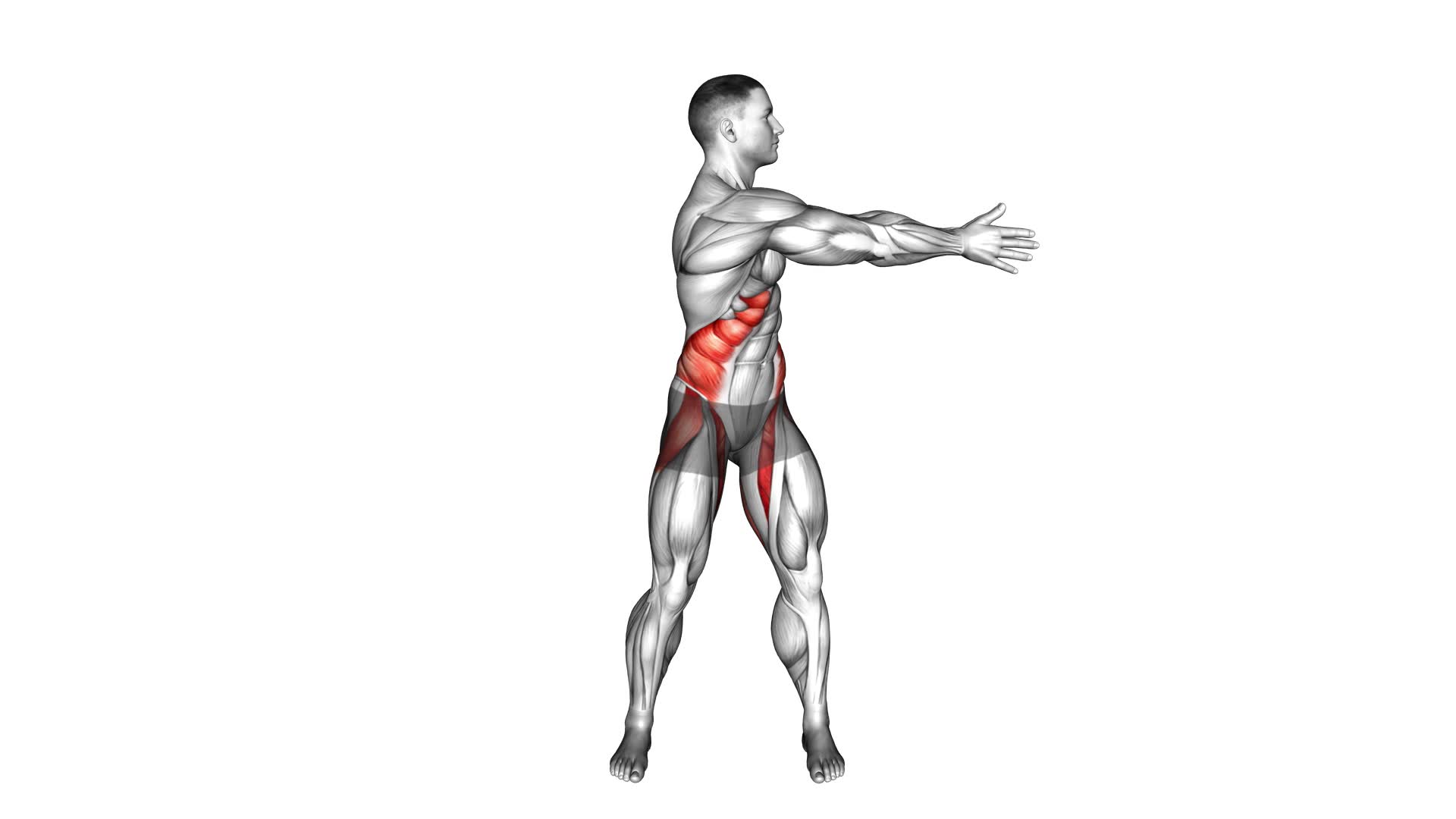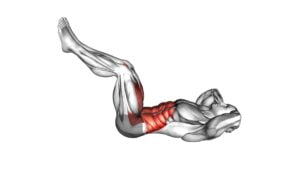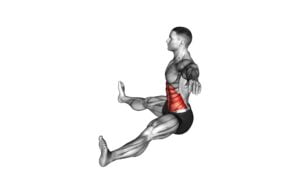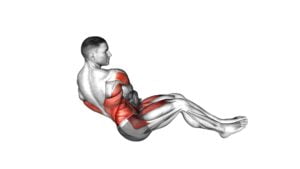Standing Ab Twist (male) – Video Exercise Guide & Tips

Are you looking to strengthen your core and improve your overall fitness? Look no further than the Standing Ab Twist.
Watch This Exercise Video
This exercise targets your abdominal muscles while also engaging your obliques and lower back. In this video exercise guide, you'll learn the proper form and technique, variations for advanced training, common mistakes to avoid, and tips for maximizing your workout.
Get ready to sculpt those abs and take your fitness to the next level. Let's get twisting!
Key Takeaways
- Standing Ab Twist targets abdominal muscles, obliques, and lower back.
- Proper form and technique involve maintaining a strong core, rotating from the waist, and avoiding momentum or swinging.
- Advanced variations include using resistance bands or weights to increase resistance and challenge core stability.
- Common mistakes to avoid include not engaging the core, twisting too forcefully, and not maintaining proper form to prevent injuries.
Benefits of the Standing Ab Twist
You should regularly incorporate the Standing Ab Twist into your workout routine because it offers numerous benefits. This exercise specifically targets your abdominal muscles, helping to strengthen and tone them. By twisting from side to side, you engage the obliques, which are responsible for the rotational movements of your torso. This not only improves your overall core strength but also enhances your stability and balance.
One of the key benefits of the Standing Ab Twist is that it can be done anywhere, without the need for any equipment. This makes it a convenient exercise to include in your routine, whether you're at the gym or in the comfort of your own home. Additionally, the Standing Ab Twist helps to improve your posture by targeting the muscles that support your spine. This can alleviate back pain and improve your overall body alignment.
To perform the Standing Ab Twist with proper form, start by standing with your feet hip-width apart. Keep your core engaged and your back straight. Begin the exercise by rotating your torso to one side, using your abdominal muscles to initiate the movement. Be sure to keep your hips and feet facing forward throughout the exercise. Slowly return to the starting position and repeat on the opposite side.
Incorporating the Standing Ab Twist into your workout routine won't only help you achieve a stronger core but also improve your posture and stability. Remember to maintain proper form and engage your abdominal muscles throughout the exercise for optimal results.
Proper Form and Technique
To perform the Standing Ab Twist with proper form and technique, focus on maintaining a strong core and engaging the abdominal muscles throughout the exercise. This won't only maximize the effectiveness of the exercise but also help prevent injuries. Start by standing with your feet hip-width apart and your knees slightly bent. Keep your spine straight and your shoulders relaxed. Place your hands on your hips or clasp them together in front of your chest.
As you twist, imagine that you're rotating from your waist, not just your arms. Slowly twist your torso to one side, keeping your hips facing forward. Exhale as you twist and try to touch your opposite elbow to your knee. Hold this position for a moment, feeling the contraction in your obliques. Return to the starting position and repeat on the other side.
It's important to avoid using momentum or swinging your upper body during the exercise. This can strain your back and decrease the effectiveness of the workout. Instead, focus on controlled and deliberate movements.
If you find the Standing Ab Twist too challenging, there are effective modifications you can try. You can decrease the range of motion by not twisting as far or by keeping your feet closer together. You can also perform the exercise seated on a stability ball or a bench for added support.
Variations for Advanced Training
Now that you have mastered the proper form and technique of the standing ab twist, it's time to take your training to the next level with some advanced variations.
One option is to incorporate resistance bands into your twist, which will add an extra challenge by providing constant tension throughout the movement.
Another way to intensify the exercise is by adding weights, such as dumbbells or a medicine ball, to increase the resistance and engage your core even more.
These variations will help you further strengthen and tone your abdominal muscles, taking your workout to new heights.
Twisting With Resistance Bands
For advanced training, incorporate resistance bands into your twisting exercises. Resistance bands offer numerous benefits for your workout routine. They provide constant tension throughout the movement, engaging your muscles more effectively. By adding resistance bands to your twisting exercises, you can intensify the workout and target your core muscles even more.
One advanced twisting technique is the standing twist with resistance bands. Start by attaching the resistance band to a sturdy anchor point and hold the handles in front of your chest. As you twist your torso to one side, pull the resistance band across your body, engaging your obliques. Return to the starting position and repeat on the other side. This exercise challenges your core stability and strengthens your abdominal muscles.
Remember to maintain proper form and control throughout the movement.
Adding Weights for Challenge
Incorporate additional weights to further challenge your twisting exercises and enhance your advanced training routine. Adding resistance to your standing ab twist exercises can significantly increase the intensity and effectiveness of your core strengthening workout.
By incorporating weights such as dumbbells or a medicine ball, you aren't only engaging your abdominal muscles but also working on your upper body strength. To perform this variation, hold the weight close to your chest with both hands while maintaining proper form and balance.
As you twist your torso from side to side, the added resistance will engage your core muscles even more, making this exercise more challenging and beneficial for overall strength and stability. Remember to start with lighter weights and gradually increase the resistance as you progress.
Common Mistakes to Avoid
To ensure proper form during the standing ab twist exercise, make sure to keep your core engaged and your back straight. This will help prevent injuries and maximize the effectiveness of the exercise.
If you find the exercise too challenging, there are modifications available, such as reducing the range of motion or using lighter weights, that can still provide a great workout for your abs.
Proper Form Demonstration
Watch your posture and movement to ensure you perform the Standing Ab Twist exercise correctly and avoid common mistakes. Here are some tips to help you maintain proper form during the exercise:
- Standing ab twist modifications: If you're a beginner or have any lower back issues, you can start by performing the exercise with your feet hip-width apart instead of together. This will provide more stability and reduce strain on your lower back.
- Standing ab twist progressions: Once you have mastered the basic form, you can progress the exercise by adding resistance. Hold a dumbbell or medicine ball in front of your chest while performing the twist. This will increase the challenge and engage your abdominal muscles even more.
- Focus on core engagement: Throughout the exercise, make sure to engage your core muscles by pulling your belly button towards your spine. This will help stabilize your spine and prevent excessive twisting or strain on your lower back.
Injury Prevention Techniques
Avoiding common mistakes is crucial for injury prevention during the Standing Ab Twist exercise. To prevent injuries, it's important to maintain proper alignment and technique throughout the exercise.
One common mistake to avoid is twisting too forcefully, as this can strain your back and cause injury. Instead, focus on controlled movements, engaging your core muscles to provide stability and support.
Another mistake to watch out for is using momentum to power through the exercise. This not only diminishes the effectiveness of the workout but also increases the risk of injury. Keep the movements slow and controlled, emphasizing the twist in your torso rather than relying on momentum.
Effective Modifications Available
To effectively modify the Standing Ab Twist exercise and avoid common mistakes, you should incorporate variations and adjustments into your routine. Here are three modifications that can benefit individuals at different fitness levels:
- Decrease the range of motion: If you're a beginner or have limited mobility, you can modify the exercise by reducing the range of motion. Instead of twisting your upper body fully, start with smaller movements and gradually increase as you become more comfortable.
- Use a resistance band: To add extra challenge and engage your muscles further, incorporate a resistance band into the exercise. Wrap the band around your hands and hold it while performing the twist. This modification increases the intensity and helps build strength in your core.
- Perform the exercise seated: If you have difficulty balancing in a standing position or prefer a seated workout, you can modify the exercise by sitting on a stability ball or chair. This modification still targets your abdominal muscles effectively while providing additional support and stability.
Tips for Maximizing Your Workout
To get the most out of your workout, incorporate these tips into your routine.
Maximizing results and increasing workout intensity are key goals for many individuals. First, make sure to warm up properly before starting any exercise. This will help prepare your muscles and prevent injuries.
Additionally, consider adding interval training to your routine. Alternating between high-intensity bursts of exercise and periods of rest can increase calorie burn and improve cardiovascular fitness.
Don't forget to push yourself during your workout. Challenge your body by increasing weights, reps, or intensity levels gradually over time. This will help prevent plateaus and keep your body progressing.
Incorporating compound exercises, such as squats, lunges, and deadlifts, can also maximize your workout. These exercises engage multiple muscle groups simultaneously, increasing the overall intensity.
Finally, prioritize rest and recovery. Give your body time to repair and rebuild between workouts to avoid overtraining.
Sample Standing Ab Twist Workout Routine
Are you ready to incorporate the Standing Ab Twist into your workout routine to target your core muscles even further? Here is a sample Standing Ab Twist workout routine that you can try:
- Start with a warm-up: Before starting the Standing Ab Twist, it's important to warm up your muscles. You can do some light cardio exercises like jogging or jumping jacks for about 5 minutes to get your blood flowing and loosen up your muscles.
- Perform the Standing Ab Twist: Stand with your feet shoulder-width apart and hold a dumbbell or medicine ball in front of your chest. Engage your core muscles and rotate your torso to the right, keeping your hips facing forward. Return to the starting position and then rotate to the left. Repeat this movement for 10-12 reps on each side.
- Modify and increase intensity: To modify the exercise, you can start by using a lighter weight or no weight at all. As you get stronger, you can gradually increase the weight to challenge your core muscles even more. Additionally, you can increase the number of reps or sets to further intensify the workout.
Remember to listen to your body and stop if you feel any pain or discomfort. Stay consistent with your workout routine and gradually increase the intensity to see improvements in your core strength.
Frequently Asked Questions
How Many Calories Can I Expect to Burn by Doing the Standing Ab Twist Exercise?
When you do the standing ab twist exercise, you might wonder how many calories you can burn. The number of calories burned will depend on various factors such as your weight, intensity, and duration of the exercise.
Proper form and technique are crucial for this exercise to effectively target your abdominal muscles. You can also modify and vary the exercise by using weights or adjusting the speed and range of motion.
Can I Do the Standing Ab Twist Exercise if I Have Lower Back Pain?
If you have lower back pain, it's important to be cautious when doing the standing ab twist exercise. There are alternative exercises you can try that are less likely to aggravate your back.
Additionally, incorporating stretching exercises for your lower back can help alleviate pain and increase flexibility.
It's always a good idea to consult with a healthcare professional or a certified trainer to get personalized advice for your specific situation.
Is It Necessary to Use a Dumbbell or Can I Perform the Exercise Without Any Equipment?
You don't need a dumbbell for the standing ab twist exercise. There are variations you can perform without any equipment.
You can modify the exercise by using your body weight or incorporating other movements. For example, you can try twisting your torso from side to side without holding anything. This can still engage your abdominal muscles and provide a good workout.
Can the Standing Ab Twist Exercise Help in Reducing Belly Fat?
The standing ab twist exercise is a great way to work your abdominal muscles, but it may not be the most effective exercise for reducing belly fat. To target belly fat, it's important to incorporate a combination of cardiovascular exercise, resistance training, and a healthy diet.
There are other exercises that can help with belly fat reduction, such as planks, Russian twists, and bicycle crunches. These exercises engage multiple muscle groups and can help burn calories and build lean muscle mass.
How Many Reps and Sets Should I Do for the Standing Ab Twist Exercise to See Results?
To see results with the standing ab twist exercise, it's important to focus on the number of sets and maintaining proper form. The number of reps and sets will vary depending on your fitness level and goals.
Start with a moderate number of reps, around 10-15 per set, and aim for 2-3 sets. Remember to engage your core, twist from your waist, and keep your back straight throughout the exercise for maximum effectiveness.
Conclusion
In conclusion, the standing ab twist is a highly effective exercise for targeting the abdominal muscles and improving core strength.
By following proper form and technique, you can maximize the benefits of this exercise and avoid common mistakes.
Incorporating variations and tips mentioned in this article can help you advance your training and achieve better results.
Remember to consult a fitness professional before starting any new exercise routine.

Author
Years ago, the spark of my life’s passion ignited in my mind the moment I stepped into the local gym for the first time. The inaugural bead of perspiration, the initial endeavor, the very first surge of endorphins, and a sense of pride that washed over me post-workout marked the beginning of my deep-seated interest in strength sports, fitness, and sports nutrition. This very curiosity blossomed rapidly into a profound fascination, propelling me to earn a Master’s degree in Physical Education from the Academy of Physical Education in Krakow, followed by a Sports Manager diploma from the Jagiellonian University. My journey of growth led me to gain more specialized qualifications, such as being a certified personal trainer with a focus on sports dietetics, a lifeguard, and an instructor for wellness and corrective gymnastics. Theoretical knowledge paired seamlessly with practical experience, reinforcing my belief that the transformation of individuals under my guidance was also a reflection of my personal growth. This belief holds true even today. Each day, I strive to push the boundaries and explore new realms. These realms gently elevate me to greater heights. The unique combination of passion for my field and the continuous quest for growth fuels my drive to break new ground.



